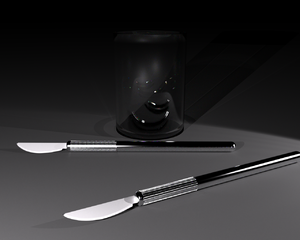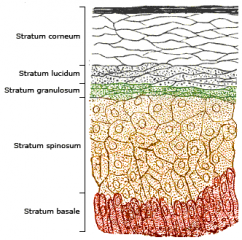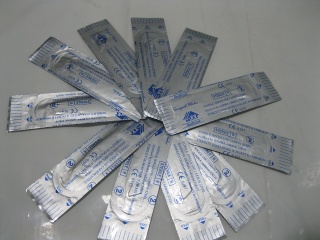 |
Peter Masters |
Peter Masters |
|
|
|||||
| About me | About this site | My books | |||||||
Practical Cutting

Figure 1. Hobby knife with disposable blade

Figure 2. The layers of the skin

Figure 3. Disposable knife blades in individual sterile packets

Figure 4. Do not cut near the eyes
Skin
Cutting is a form of edge play which involves using a sharp knife or scalpel to cut through the outer layers of skin to cause pain, to create permanent or temporary designs in the skin, or to install fear ala' a mind fuck.
Cutting should not be attempted without first getting instruction from an experienced practitioner.
The least invasive forms of cutting only involve the outer one or two layers of skin cells. These are shown in figure 2 as the stratum corneum and stratum lucid. Both of these layers consist only of dead skin cells and serve as protection for the layers underneath. Cutting these layers is typically pain free and blood free and is mainly done for the psychological effect.
Cutting deeper than these two layers risks damage to:
- Nerves
- Muscles
- Major veins or arteries
This damage may take a long time to heal, or it may be irreversible.
Any bleeding caused by cutting, if it occurs at all, should stop within a few minutes. The skin should heal within a few weeks.
Scarring
To prevent scarring, use adhesive bandages to hold the edges of the wound together during healing. Or, alternatively, use very, very light pressure on the knife when cutting to minimise the damage.
To cause scarring, use adhesive bandages which hold the edges of the cut apart during healing. Or, alternatively, press a little harder to get a slightly deeper (and more painful) cut.
Knives
While an obvious place to look for knives to use in cutting would be a medical supply company or pharmacy, the hobby knives found in art supply shops or hobby stores are frequently good alternatives (see figure 1). In fact, it's common to find that the replaceable blades used in these knives are supplied in individual sealed sterile packets (see figure 3). This is because these knife blades are often the same ones used in medical procedures.
The best types of knives to use are those with replaceable blades. This avoids the need to sharpen them, and reduces the need to disinfect because a new blade can easily and cheaply be used on each separate partner or occasion.
Where to cut
Common body areas for cutting include:
- Upper arms
- Breasts or chest
- Belly
- Buttocks
- Thighs
Beware of cutting near joints. The flexing of the skin near the joint can make healing difficult or messy.
Also beware of cutting where there are veins, nerves bundles, or muscles close to the surface of the skin such as the wrist, back of the knee, other joints, etc.
The face and neck are, in particular, very risky areas to cut because of the muscles, nerves and blood vessels very close to the surface of the skin.
Cutting
Before cutting, make sure that the area where you will be cutting is clean and disinfected. You can buy individual cleaning swabs soaked in disinfectant at medical supply stores or in pharmacies. Also wear latex gloves to prevent any of your skin oil or sweat contaminating the wound.
There are many medical disinfectants and treatments available especially for wounds, lesions, and rashes. Be wary about using these to sterilise the skin area where you'll be cutting because they may contain an anaesthetic to reduce the pain and this often defeats the purpose of the cutting in the first place.
When actually cutting, start by pressing very lightly. The knives and scalpels you'll be using are usually extremely sharp. You may only want to cut through one or two layers of skin and pressing will likely lead to deep cuts and subcutaneous damage.
If you are cutting with the intent of leaving a design in the form of scarring, it's common to build up the design over a number of weeks to allow healing to occur. This is because cutting weakens the fabric of the skin and can lead to tearing between cuts. For example, if you cut a deep "X" into someone's skin, it's likely that the skin at the centre of the "X" will detach or peel back.
If you want to cut an "X", you should cut a "/" in one session, wait a week or two for it to heal and then cut a "\" across the earlier "/". The result will be a clean "X" scar.
Alternatively, if you must do the "X" in a single session, do one long cut for the "/" and then two shorter cuts which jump over the "/" for the "\". In other words, the "\" is formed by two lines which come close to the "/" but which don't cut through it (a bit like this: "`/.").
After the cutting, clean the skin area and press gauze against the wound(s) until any bleeding stops.